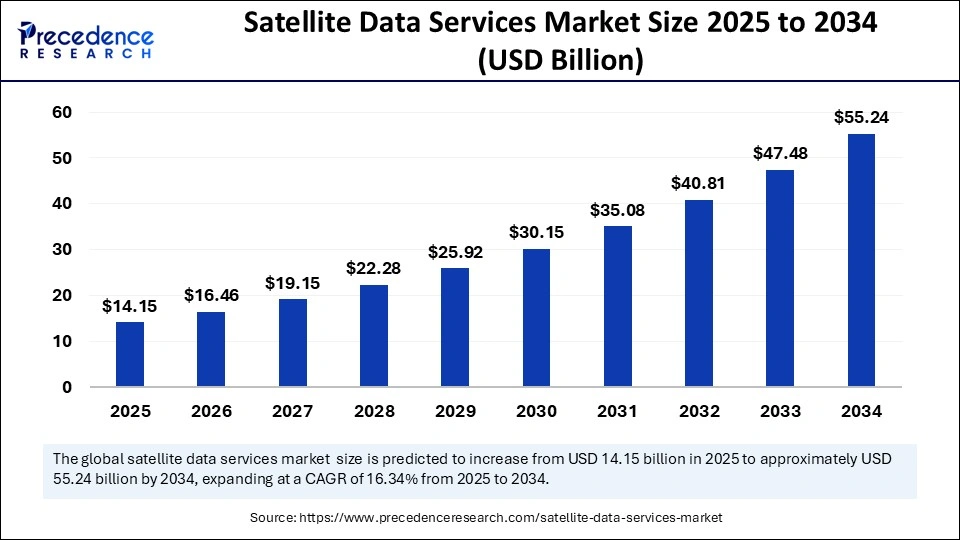
Satellite Data Services Market Key Takeaways
- North America dominated the global market with the largest market share of 37% in 2024.
- Asia Pacific is observed to expand at a rapid CAGR of 19.04% during the forecast period.
- By service, the image data services segment accounted for the dominant market share in 2024.
- By service, the data analytics services segment is expected to expand at the fastest CAGR during the forecast period.
- By deployment, the private segment held the largest share of the market in 2024.
- By deployment, the public segment is expected to grow significantly during the forecast period.
- By application, the defense & security segment accounted for the highest share in 2024.
- By application, the environmental & climate monitoring segment is expected to grow at the fastest CAGR between 2025 and 2034.
- By end-use, the commercial segment dominated the market in 2024.
- By end-use, the service providers segment is expected to grow at the highest CAGR in the coming years.
Market Overview
The satellite data services market has evolved into a cornerstone of the global data economy, driven by the increasing demand for real-time, geospatial intelligence across various industries. These services include image data, radar data, and value-added analytics collected from Earth observation satellites. Applications span environmental monitoring, agriculture, oil and gas exploration, defense, disaster response, and urban planning. With advancements in satellite technology, miniaturization of components, and cost-effective launch solutions, the market is transitioning from a predominantly government-driven domain to a more commercial and enterprise-focused space.
Drivers
Key drivers influencing the satellite data services market include the growing need for high-resolution Earth imagery and the rising adoption of geospatial analytics. The proliferation of small satellite constellations has enabled more frequent data collection, enhancing accuracy and utility for time-sensitive applications. In addition, climate change monitoring, smart agriculture practices, and increased demand from the energy and mining sectors are accelerating market expansion. The integration of satellite data with artificial intelligence and big data platforms is further boosting market momentum by offering predictive insights and automated interpretation.
Opportunities
Significant opportunities lie in the development of industry-specific satellite data solutions, particularly in precision agriculture, maritime surveillance, and smart city development. As industries transition toward data-driven operations, customized satellite insights are becoming invaluable. There is also a rising demand for cloud-based platforms that offer easy access, processing, and visualization of satellite data. Governments and international organizations are providing incentives and funding for Earth observation projects, creating room for startups and smaller vendors to enter and innovate in the space.
Challenges
Despite promising growth, the satellite data services market faces several challenges. High initial costs for satellite deployment and the need for specialized infrastructure to manage and interpret complex data formats remain substantial barriers. Data latency, especially in applications requiring real-time responsiveness, continues to be a technical hurdle. Additionally, regulatory constraints on data usage, privacy, and international data sharing can limit the seamless integration of satellite intelligence into public and private workflows.
Regional Insights
North America dominates the satellite data services market, thanks to robust investments in space technologies, a strong defense sector, and commercial interest in geospatial analytics. Europe is rapidly expanding its presence, supported by the Copernicus program and widespread adoption in environmental monitoring. The Asia-Pacific region is poised for the fastest growth due to rapid urbanization, agricultural transformation, and increased satellite launches by countries like China, India, and Japan. Latin America and Africa are emerging markets, leveraging satellite data to improve disaster management and rural development.
Recent Developments
Recent developments include partnerships between satellite data providers and AI firms to enhance data interpretation capabilities. Several companies have launched next-generation low Earth orbit (LEO) satellite constellations to improve data refresh rates. There’s also a trend toward open-access satellite data platforms supported by governmental space agencies to democratize data availability. Additionally, mergers and acquisitions are consolidating the market as established players acquire niche data analytics firms to broaden their service portfolios.
Satellite Data Services Market Companies
- Maxar Technologies Holdings Inc. (Maxar)
- Planet Labs PBC.
- Airbus SE
- ICEYE
- L3Harris Technologies, Inc.
- Earth-i Ltd
- Geocento Limited
- NV5 Global, Inc.
- Satellite Imaging Corporation
- Satpalda
- Telstra
- Ursa Space Systems Inc.
- Geospatial Intelligence Pty Ltd
Segments Covered in the Report
By Service
- Image Data Services
- Data Analytics Services
By Deployment
- Private
- Public
- Hybrid
By Application
- Defense & Security
- Energy & Utilities
- Agriculture & Forestry
- Environmental & Climate Monitoring
- Engineering & Infrastructure Development
- Marine
- Others
By End-use
- Commercial
- Government and Military
- Service Providers
By Region
- North America
- Europe
- Asia Pacific
- Latin America
- Middle East and Africa (MEA)